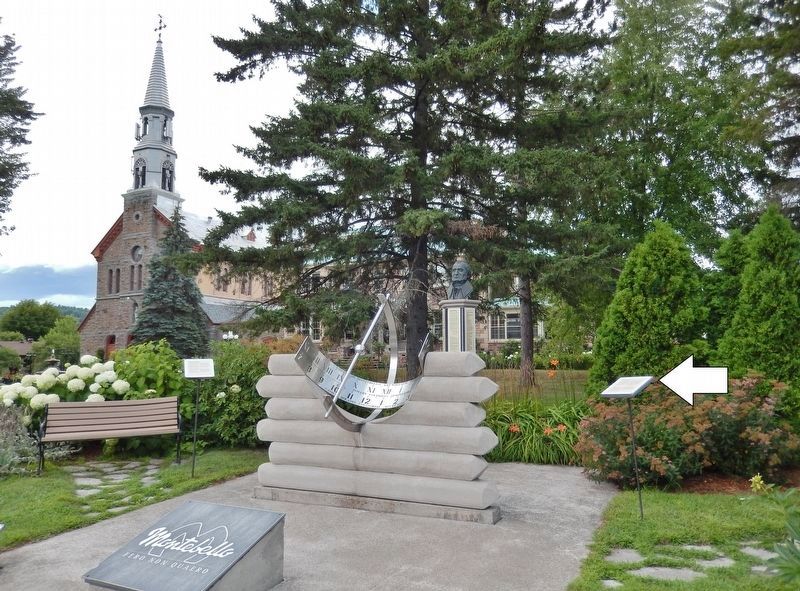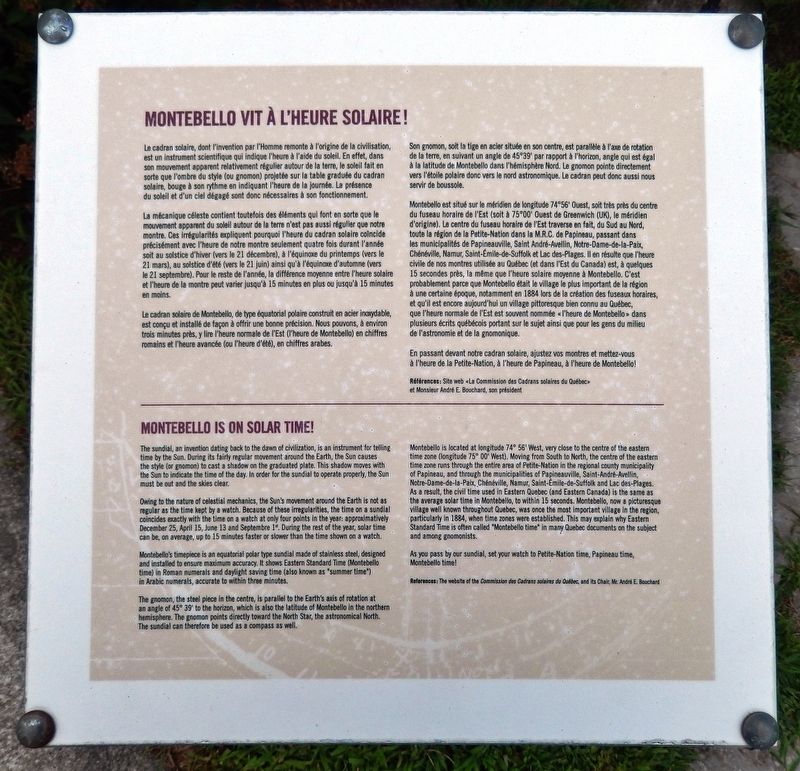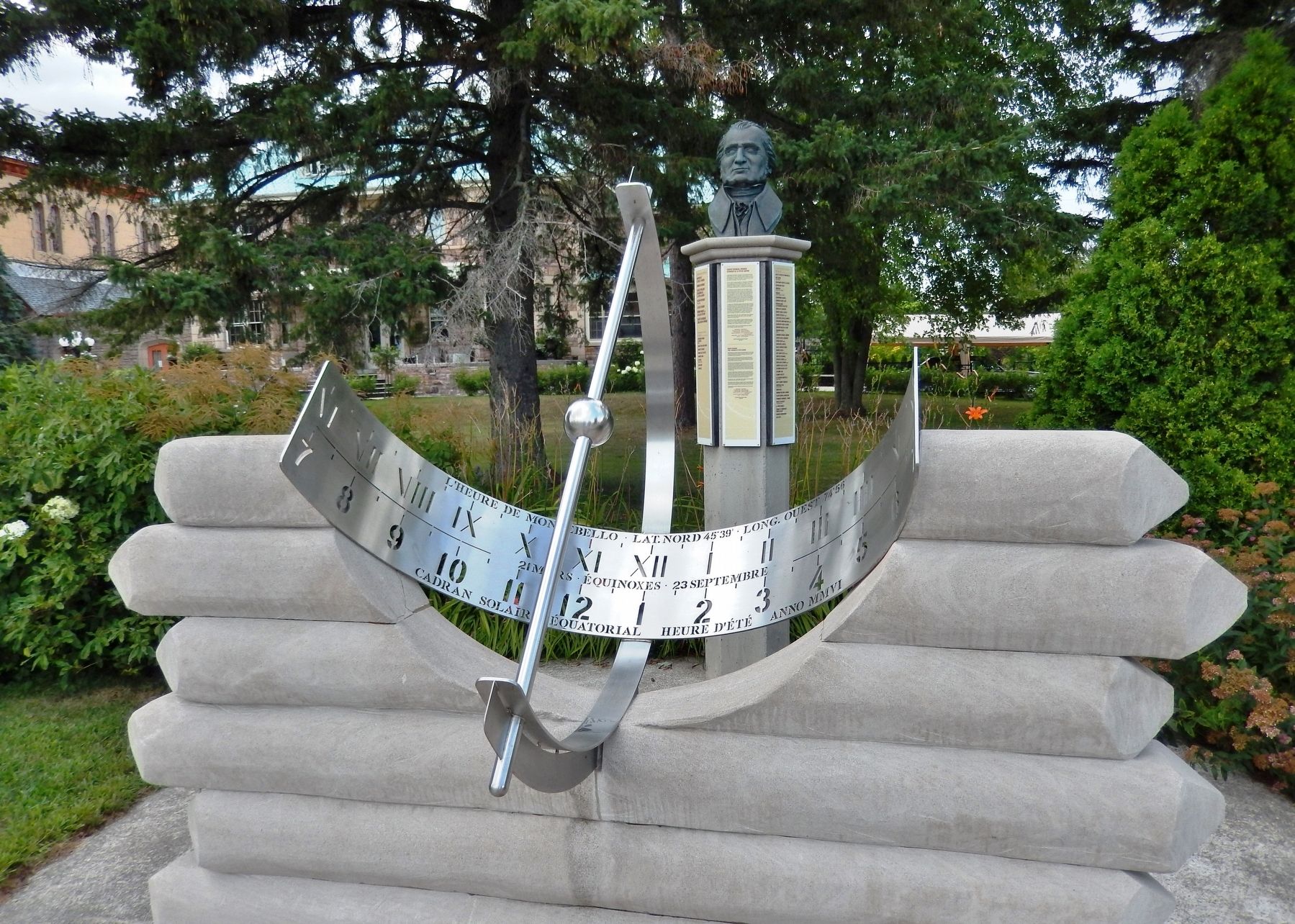Montebello in Papineau, Québec — Central Canada (French-Canadian)
Montebello Vit À L’heure Solaire ! / Montebello Is On Solar Time!
Inscription.
Le cadran solaire, dont l'invention par l'Homme remonte à l'origine de la civilisation, est un instrument scientifique qui indique l'heure à l'aide du soleil. En effet, dans son mouvement apparent relativement régulier autour de la terre, le soleil fait en sorte que l'ombre du style (ou gnomon) projetée sur la table graduée du cadran solaire, bouge à son rythme en indiquant l'heure de la journée. La présence du soleil et d'un ciel dégagé sont donc nécessaires à son fonctionnement.
La mécanique céleste contient toutefois des éléments qui font en sorte que le mouvement apparent du soleil autour de la terre n'est pas aussi régulier que notre montre. Ces irrégularités expliquent pourquoi l'heure du cadran solaire coïncide précisément avec l'heure de notre montre seulement quatre fois durant l'année soit au solstice d'hiver (vers le 21 décembre), à l'équinoxe du printemps (vers le 21 mars), au solstice d'été (vers le 21 juin) ainsi qu'à l'équinoxe d'automne (vers le 21 septembre). Pour le reste de l'année, la différence moyenne entre l'heure solaire et l'heure de la montre peut varier jusqu'à 15 minutes en plus ou jusqu'à 15 minutes en moins.
Le cadran solaire de Montebello, de type équatorial polaire construit en acier inoxydable, est conçu et installé de façon à offrir une bonne précision. Nous pouvons, à environ trois minutes près, y lire l'heure normale de l'Est (l'heure de Montebello) en chiffres romains et l'heure avancée (ou l'heure d'été), en chiffres arabes.
Son gnomon, soit la tige en acier située en son centre, est parallèle à l'axe de rotation de la terre, en suivant un angle de 45°39' par rapport à l'horizon, angle qui est égal à la latitude de Montebello dans l'hémisphère Nord. Le gnomon pointe directement vers l'étoile polaire donc vers le nord astronomique. Le cadran peut donc aussi nous servir de boussole.
Montebello est situé sur le méridien de longitude 74°56' Ouest, soit très près du centre du fuseau horaire de l'Est (soit à 75°00' Ouest de Greenwich (UK), le méridien d'origine). Le centre du fuseau horaire de l'Est traverse en fait, du Sud au Nord, toute la région de la Petite-Nation dans la M.R.C, de Papineau, passant dans les municipalités de Papineauville, Saint André-Avellin, Notre-Dame-de-la-Paix, Chénéville, Namur, Saint-Émile-de-Suffolk et Lac des-Plages. Il en résulte que l'heure civile de nos montres utilisée au Québec (et dans l'Est du Canada) est, à quelques 15 secondes près, la même que l'heure solaire moyenne à Montebello. C'est probablement

Photographed By Cosmos Mariner, August 9, 2019
2. Montebello Vit À L’heure Solaire ! /
Montebello Is On Solar Time! Marker
Montebello Is On Solar Time! Marker
• • •
(Notre-Dame-de-Bon-Secours cathedral and related sundial marker in left background)
En passant devant notre cadran solaire, ajustez vos montres et mettez-vous à l'heure de la Petite-Nation, à l'heure de Papineau, à l'heure de Montebello !
Références: Site web « La Commission des Cadrans solaires du Québec » et Monsieur André E. Bouchard, son président
The sundial, an invention dating back to the dawn of civilization, is an instrument for telling time by the Sun. During its fairly regular movement around the Earth, the Sun causes the style (or gnomon) to cast a shadow on the graduated plate. This shadow moves with the Sun to indicate the time of the day. In order for the sundial to operate properly, the Sun must be out and the skies clear.
Owing to the nature of celestial mechanics, the Sun's movement around the Earth is not as regular as the time kept by a watch. Because of these irregularities, the time on a sundial coincides exactly with the time on a watch at only four points in the
year: approximately December 25, April 15, June 13 and September 1st. During the rest of the year, solar time can be, on average, up to 15 minutes faster or slower than the time shown on a watch.
Montebello's timepiece is an equatorial polar type sundial made of stainless steel, designed and installed to ensure maximum accuracy. It shows Eastern Standard Time (Montebello time) in Roman numerals and daylight saving time (also known as "summer time") in Arabic numerals, accurate to within three minutes.
The gnomon, the steel piece in the centre, is parallel to the Earth's axis of rotation at an angle of 45° 39' to the horizon, which is also the latitude of Montebello in the northern hemisphere. The gnomon points directly toward the North Star, the astronomical North. The sundial can therefore be used as a compass as well.
Montebello is located at longitude 74° 56' West, very close to the centre of the eastern time zone (longitude 75° 00' West). Moving from South to North, the centre of the eastern time zone runs through the entire area of Petite-Nation in the regional county municipality of Papineau, and through the municipalities of Papineauville, Saint-André-Avellin, Notre-Dame-de-la-Paix, Chénéville, Namur, Saint-Émile-de-Suffolk et Lac des-Plages. As a result, the civil time used in Eastern Quebec (and Eastern Canada) is the same as the average solar time in Montebello, to within 15 seconds. Montebello, now a picturesque village well known throughout Quebec, was once the most important village in the region, particularly in 1884, when time zones were established. This may explain why Eastern Standard Time is often called "Montebello time" in many Quebec documents on the subject and among gnomonists.
As you pass by our sundial, set your watch to Petite-Nation time, Papineau time, Montebello time!
References: The website of the Commission des Cadrans solaires du Québec, and its Chair, Mr. André E. Bouchard
Topics. This historical marker is listed in this topic list: Science & Medicine. A significant historical year for this entry is 1884.
Location. 45° 39.02′ N, 74° 56.35′ W. Marker is in Montebello, Québec, in Papineau. Marker is on Rue Notre Dame (Québec Route 148) west of Rue Laval, on the right when traveling west. Marker and sundial are located in a small plaza beside the sidewalk. Touch for map. Marker is at or near this postal address: 545 Rue Notre Dame, Montebello QC J0V 1L0, Canada. Touch for directions.
Other nearby markers. At least 8 other markers are within walking distance of this marker. Joseph Papineau (here, next to this marker); Le Cadran Solaire de Montebello / The Montebello Sundial (here, next to this marker); Le Presbytère / The Rectory (a few steps from this marker); L'Hôtel de Ville / Town Hall (within shouting distance of this marker); L’Église / The Church (within shouting distance of this marker); Le Couvent / The Convent (about 120 meters away, measured in a direct line); La Maison Barolet / The Barolet House (about 150 meters away); Statue of Liberty Replica (about 180 meters away). Touch for a list and map of all markers in Montebello.
Also see . . . Commission des Cadrans solaires du Québec. Savez-vous qu'il y a un instrument dont la fonction n'a pas varié depuis la nuit des temps et qui existe toujours aujourd'hui selon son principe immuable? Il s'agit du cadran solaire.
• • •
Did you know that there is an instrument whose function has not changed since the dawn of time and which still exists today according to its immutable principle? This is the sundial. (Submitted on June 19, 2020, by Cosmos Mariner of Cape Canaveral, Florida.)
Credits. This page was last revised on June 19, 2020. It was originally submitted on June 19, 2020, by Cosmos Mariner of Cape Canaveral, Florida. This page has been viewed 153 times since then and 16 times this year. Photos: 1, 2, 3. submitted on June 19, 2020, by Cosmos Mariner of Cape Canaveral, Florida.

